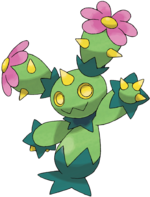Maractus
Jump to navigation
Jump to search

| |||
| The Cactus Pokémon | |||
| #556 - Maractus | |||
| Debut | Pokémon: Black Version Pokémon: White Version | ||
| Species Info | |||
| Type | |||
| Height | 1 m (3'03") | ||
| Weight | 28 kg (61.7 lbs.) | ||
| Color | Green | ||
| Gender Ratio | 1♂ : 1♀ | ||
| Ability | Water Absorb / Chlorophyll | ||
| Hidden Ability | Storm Drain | ||
| Egg Group | Plant | ||
| Icon | Sprite | ||
| File:I556.gif | File:556sprite.png | ||
| Footprint | |||
| 30px | |||
| Base Statistics | |||
| Hit Points | 75 | Speed | 60 |
| Attack | 86 | Sp. Attack | 106 |
| Defense | 67 | Sp. Defense | 67 |
| Training Info | |||
| Catch Rate | 255 | Hatch Steps | 5,120 |
| Base Exp. | 161 | Effort Points | SpA |
| Happiness | 70 | SpA | |
| To Lv.100 | Normal | ||
| Kanto # | Johto # | Hoenn # | Sinnoh # |
|---|---|---|---|
| < 556 > | |||
| Unova # | Johto (IV) # | ||
| < 062 > |
Maractus is a cactus-like Pokémon that was introduced in the fifth generation games and is not connected to any evolutionary line.
Information[edit]
They live primarily in arid habitats. Maractus usually move rhythmically and make sounds similar to maracas. They have been known to use up-tempo songs and dances to drive away the birds that feed on their seeds.
Appearances[edit]
Mainstream Games[edit]
In Pokémon: Black and White Versions, Maractus were uncommonly found at the Desert Resort.
Other Games[edit]
In Pokémon Rumble Blast, Maractus was found at the desert area of the Rugged Flats. In PokéPark 2: Wonders Beyond, three Maractus appeared at Seasong Beach in the Cove Area, but one was separated from the rest. The player could reunite the trio to befriend them.
Other Appearances[edit]
Other Media[edit]
- In the Pokémon anime, one episode featured a trainer with a Maractus trio who prepared them for the Pokémon Musical and had a triple battle against Ash to help prepare them.
- In the Pokémon Adventures manga, Maractus was featured in a chapter of the Black/White arc where it was used by a Team Plasma grunt who was disguised as a construction worker on Route 4. The Maractus was easily defeated by Grimsley's Bisharp once he saw through the grunt's disguise.
Trivia[edit]
- Its name is a combination of "maraca" and "cactus", which both describe its characteristics. It was probably designed so do to both maracas and cacti being associated with desert areas.
Categories:
- Pages with broken file links
- Creatures
- Pokémon
- Grass Type Pokémon
- Green Colored Pokémon
- Water Absorb Ability Pokémon
- Chlorophyll Ability Pokémon
- Storm Drain Ability Pokémon
- Plant Egg Group Pokémon
- Pokémon that yield SpA Points
- Pokémon with catch points
- Pokémon with hatching steps
- Pokémon with exp base
- Pokémon with happiness base
- Pokémon with Lv 100